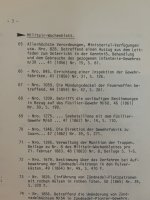Hi all,
Here's a very weird one that I mentioned a while back. This one came out of the same collection as the Doersch von Baumgarten I posted a month or so ago. Officially, this is an experimental needle rifle designed by Johann Georg Beutter of Reutlingen. These are very difficult to find information on, but I did have two German language sources I was able to consult. I know there's enough of a needle gun following here, so I thought I'd share.
Essentially, Beutter was a gunsmith that designed a new breach-loading system with a needle-fire mechanism that he wanted to try to sell to the Württemburgische military. From what I read, he was able to get an audience with military officials in January of 1850. The system borrowed some elements from the Prussian system and had an unusual 12 groove rifling in the bore. They examined the rifle and thought it was interesting, but complicated to manufacture. They requested a live fire test, but Beutter was not prepared and did not bring ammunition. The military concluded that the system was not suitable for adoption and purchased the prototype for the state model collection. Two years later, in July of 1852, Beutter again approached the military; this time with ammunition. The rifle performed well at 200 paces, but was still deemed not suitable, so Beutter requested they buy this example as well for their model collection. It appears that others were constructed, though given the size of Beutter's operation, these appear to be very few and far between. Today, they have fallen into obscurity. Any firearm from Beutter is considered extremely rare and only a small number appear to have survived.
This particular example bears SN 34. It was sporterized at some point (possibly to sell on the civilian market), though only the forend of the stock was cut and the brass rod receptacle removed and filled; it appears no other modifications were made. I plan on restoring it with an old fore end and brass ramrod guides I have on hand. The bolt operates by tilting the handle forward, lufting up and rotating like a regular bolt, the movement of the handle is what actually cocks the action (unlike the manual cocking of the Dreyse system) It's very odd.
While extremely niche, it's a neat window into early breach-loader designs and frankly a model I never thought I'd be able to hold, let alone own.
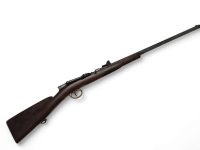
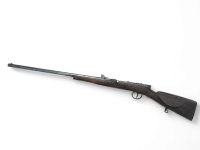
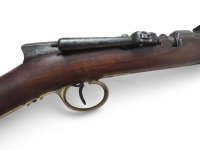
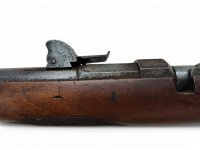
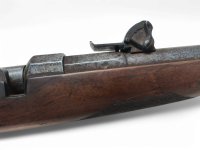
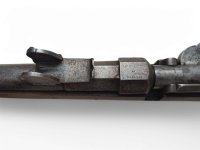

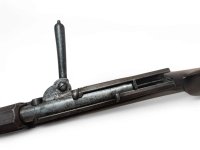
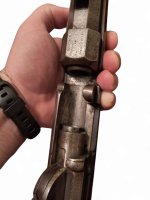


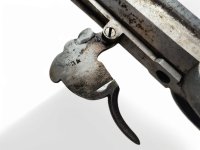

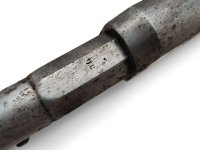
Normally, I'm not a bore photo guy, but it's pretty neat to see the 12 groove rifling....
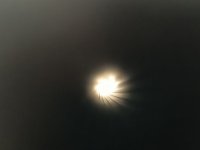
Sources:
Wirtgen, R. (1991). Das Zündnadelgewehr: Eine militärtechnische revolution im 19. Jahrhundert. E.S. Mittler.
Lehner, H. (1986, July). Eine unbekannte militär, jäger oder scharfschützenbüchse. Deutsches Waffen-Journal, 780–785.
Here's a very weird one that I mentioned a while back. This one came out of the same collection as the Doersch von Baumgarten I posted a month or so ago. Officially, this is an experimental needle rifle designed by Johann Georg Beutter of Reutlingen. These are very difficult to find information on, but I did have two German language sources I was able to consult. I know there's enough of a needle gun following here, so I thought I'd share.
Essentially, Beutter was a gunsmith that designed a new breach-loading system with a needle-fire mechanism that he wanted to try to sell to the Württemburgische military. From what I read, he was able to get an audience with military officials in January of 1850. The system borrowed some elements from the Prussian system and had an unusual 12 groove rifling in the bore. They examined the rifle and thought it was interesting, but complicated to manufacture. They requested a live fire test, but Beutter was not prepared and did not bring ammunition. The military concluded that the system was not suitable for adoption and purchased the prototype for the state model collection. Two years later, in July of 1852, Beutter again approached the military; this time with ammunition. The rifle performed well at 200 paces, but was still deemed not suitable, so Beutter requested they buy this example as well for their model collection. It appears that others were constructed, though given the size of Beutter's operation, these appear to be very few and far between. Today, they have fallen into obscurity. Any firearm from Beutter is considered extremely rare and only a small number appear to have survived.
This particular example bears SN 34. It was sporterized at some point (possibly to sell on the civilian market), though only the forend of the stock was cut and the brass rod receptacle removed and filled; it appears no other modifications were made. I plan on restoring it with an old fore end and brass ramrod guides I have on hand. The bolt operates by tilting the handle forward, lufting up and rotating like a regular bolt, the movement of the handle is what actually cocks the action (unlike the manual cocking of the Dreyse system) It's very odd.
While extremely niche, it's a neat window into early breach-loader designs and frankly a model I never thought I'd be able to hold, let alone own.














Normally, I'm not a bore photo guy, but it's pretty neat to see the 12 groove rifling....

Sources:
Wirtgen, R. (1991). Das Zündnadelgewehr: Eine militärtechnische revolution im 19. Jahrhundert. E.S. Mittler.
Lehner, H. (1986, July). Eine unbekannte militär, jäger oder scharfschützenbüchse. Deutsches Waffen-Journal, 780–785.

